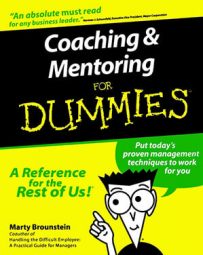Coaching an employee for improvement in performance (sometimes called counseling) is necessary when you repeatedly give negative feedback on the same issues. Performance improvement is a sensitive topic, so take an informal, prevention-minded action through constructive feedback.
Here are the steps to follow in your coaching for improvement effort with your employee:
Define the performance problem.
Summarize the pattern of performance that needs improvement. Stay away from stating why you think the problem is occurring; instead, avoid the assumptions and tell what you see happening in concrete, observable terms.
Invite the employee into the discussion.
Listen closely so that you can understand the employee's perspective on the situation. As needed, explore possible causes for the problem. Discovering root causes helps you pinpoint solutions that help improvement happen.
Don't debate, listen. Neither of you have to see exactly eye-to-eye on the problem. What you need instead is for both of you to understand what each other has to say. Quite often, by avoiding the blaming or other problem-dwelling focuses, the dynamic of the interaction has opportunity for openness, and you can both gain insight. Remember, you're here to be helpful; otherwise, why should anyone want to work with you for improvement?
Collaboratively create the plan for improvement. The improvement plan should cover these points:
Goal: The goal here is the expected level of performance you want to see from the staff person — come ready to spell that out and let the employee help define it with you for clarity.
Action plans: Work on the substance of where the solution comes from, which should define which steps the employee will take to reach the goal, and what steps you will take to support the effort. Ask the individual for ideas — brainstorm together, if needed, so that this planning and solution-building is a two-way effort.
Checkpoints: Checkpoints ensure regular follow up. They are the dates and frequency that you and your staff person are to meet to review progress with the improvement plan and update it.
How to measure: What are the means for measuring progress and outcome? Determine this by gathering feedback from others, noting your own observations, reviewing the products of work, and checking off the completed steps in the plan.
Manage by plan and do your follow-ups.
The checkpoints to review progress are best if relatively short-term initially — say, two to four weeks out. As you complete each progress review with the employee, exchange feedback on what has occurred relative to what the plan defined and update the plan accordingly. Set your next checkpoint from there.
Plan to do at least three follow-ups over a period of time with your staff person when you create a plan for improvement. Quite often, because focused attention has helped set a course for correction, you see immediate improvement. Holding follow-up meetings ensures sustained improvement (as opposed to short-term improvement), and keeps old habits from returning after the initial try.
Continuous follow-ups over time help keep positive momentum going and lay a groundwork for accountability to make the plan work. As progress is made, set the next checkpoint out farther; for example, 30 days the first time, 60 days the next time, and then 90 days. Make your goal to get this person's issue improved upon, sustained, and then maintained through the quarterly checkup meetings that you do with each of your staff.

